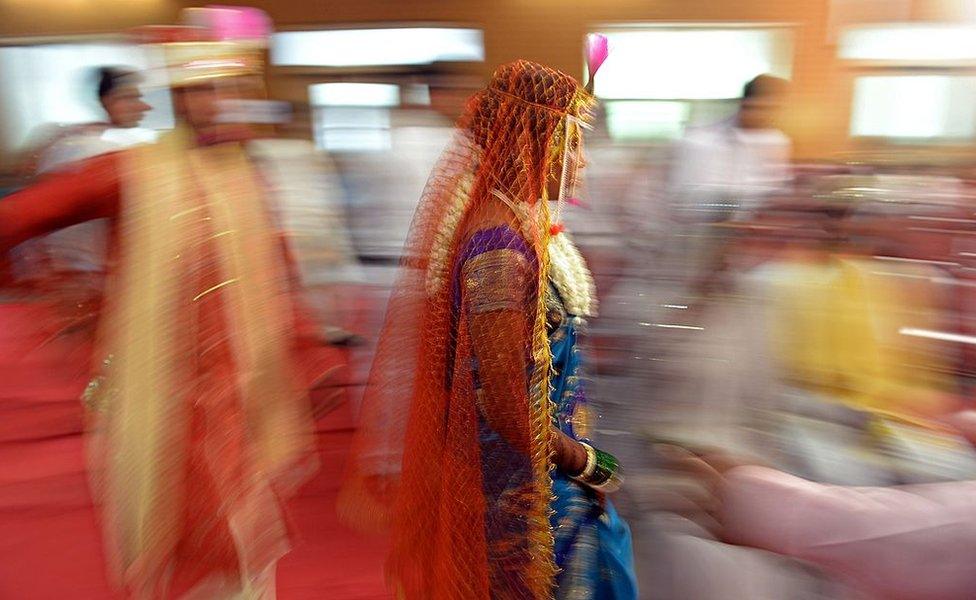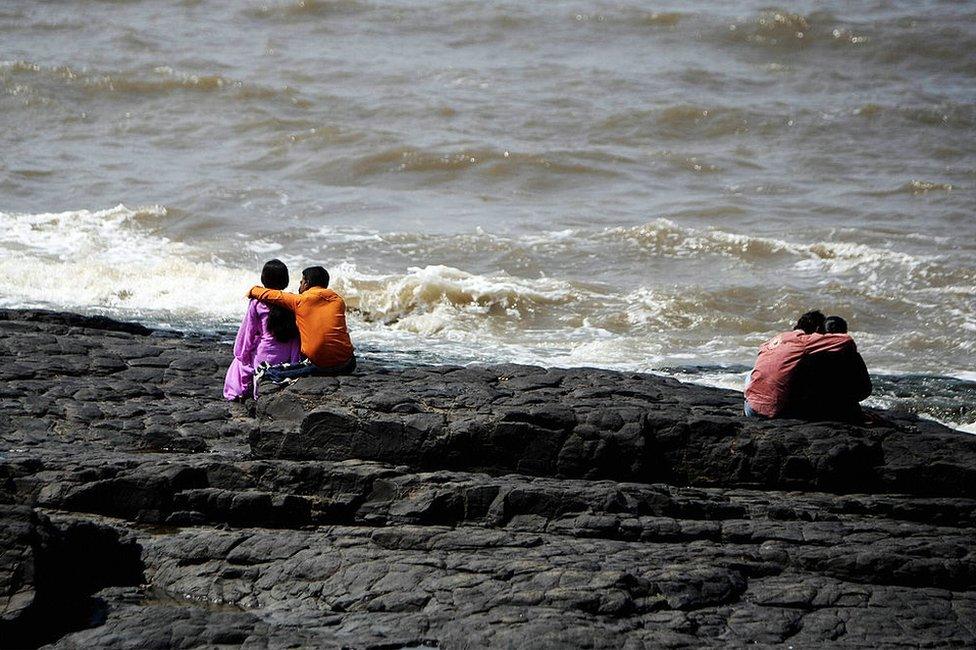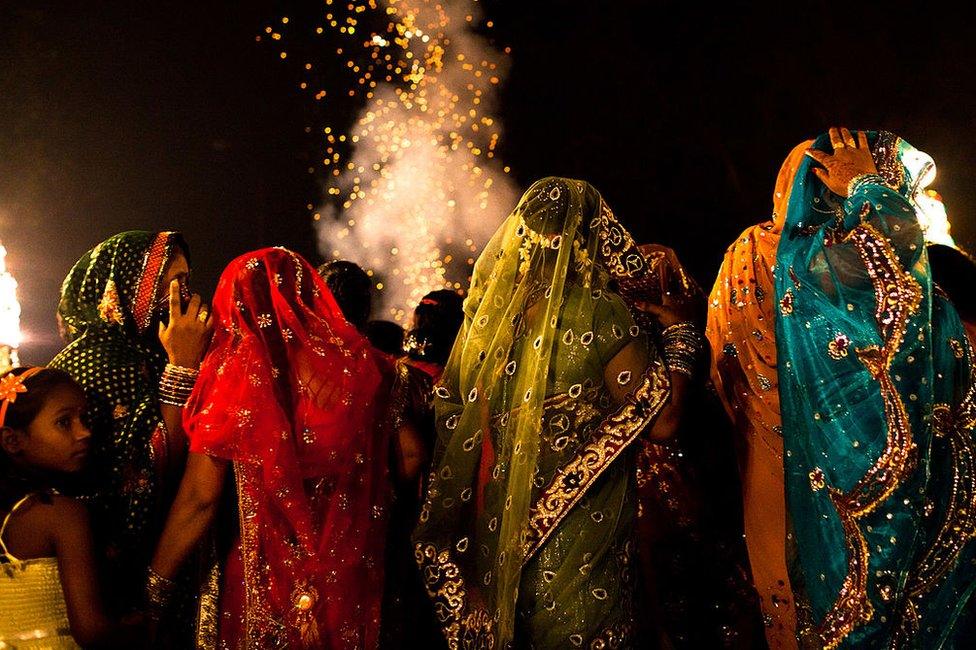What divorce and separation tell us about modern India
- Published

Less than one in 1,000 marriages end up in divorce in India
"There can be no objection to the right of divorce. But conferring this right on women, by itself, would be unmeaning and probably more productive of harm than of good," wrote a commentator in a floridly-worded essay, external in May 1949 on the changing status of women and divorce in India.
Writing in the respected journal Economic Weekly, Roma Mehta said women in India were "more protected and much better cared for than in the West"; that they found "more happiness more often than not in her home; and her troubles and heartaches were solved in family" where she lived. "The incompatibility may sometimes be very great indeed; but in spite of it all, the family is maintained."
She argued that divorce did not "concern the very vast majority of people" in a country where the economy is fundamentally rural, people are uneducated with no contact with the outside world, and the "clamour for better living is absent". So, wrote Ms Mehta, the "problems of love and hate, of marriage and remarriage, are solved on a simple plan which is worked out for the community only".
Changing equations
That was then. The landmark Hindu Code Bill, external passed in the parliament in the mid-1950s gave women property rights, outlawed polygamy and allowed partners to file for divorce. The laws were further tweaked in 1976 to allow divorce by mutual consent.
Over time, the traditional joint family has given way to nuclear families in cities and towns; and more and more women are going to work or setting up their own businesses. Many urban women no longer have to depend on their spouses for financial security, men are sharing household chores; and gender equations are slowly changing.
Now a significant study by economist Suraj Jacob and anthropologist Sreeparna Chattopadhyay has examined data from India's census , externalto offer - possibly for the first time - some insights into divorce and separation in India.

Love marriages are becoming common in India
India's census gives its citizens the following choices to select their status: never married, separated, divorced, widowed, married. It is true that some women may not report separation or divorce because of the stigma attached to the status. But here are some of the more salient findings of the study:
1.36 million people in India are divorced. That is equivalent to 0.24% of the married population, and 0.11% of the total population.
More strikingly, the number of people separated is almost thrice the number of people divorced - 0.61% of the married population and 0.29% of the total population.
More women are divorced and separated than men.
Divorce rates in north-east states are relatively higher than elsewhere in India: Mizoram has the highest divorce rate (4.08%), more than four times that of Nagaland, the state with the second highest rate (0.88%).
Gujarat reports the maximum number of divorce cases among bigger states - with a population of more than 10 million - followed by Assam, Maharashtra, West Bengal and Jammu and Kashmir.
Meghalaya has the most number of cases of separation, followed by Mizoram, Sikkim, Kerala and Chhattisgarh. Three of these five states are in north-eastern India.
What does this tell us about breakdown of marriages in today's India?
For one, more people are separated than divorced in India because of stigma associated with divorce, and the time taken in resolving disputes in the slow-moving Indian courts.

More women are divorced than men in India
The gender gap - more women divorced and separated - is even more striking, and tells a story about India's gender biases and how patriarchy operates.
This essentially means that either women are choosing to stay divorced or are not finding partners for remarriage, unlike men. "It is consistent with the bias that women face in India," says Ms Chattopadhyay. "You have the right to divorce, but remarriage remains tough because of prejudices against a divorcee."
Thirdly, the gap between divorces and separations in cities and towns and villages is "very low" - a finding that has come as a "big surprise" to the researchers. "So class may or may not make a difference, but residence does not seem to make a huge difference," they say.
'Not surprising'
Thirdly, divorce and separation rates vary wildly across states and regions.
Divorce and separation rates in the north-eastern states - where tribal laws allow for informal relations and women sometimes enjoy a relatively higher status because of a matrilineal system - are relatively higher than elsewhere in India.
Northern states like Uttar Pradesh, Bihar, Haryana and Rajasthan which are known to be deeply patriarchal, have much lower divorce and separation rates.
An international study of divorce rates of 71 countries - one of the few studies showing global comparisons - showed that they range from a low of 0.04% of the total population in Georgia to a high of 0.46% in Belarus.
Interestingly, Gujarat's divorce rate is greater than of Belarus, and Bihar's closer to Georgia suggesting a "striking level of regional diversity".
Also, say the researchers, the "divorce rates in India are neither surprising nor unsurprising".

There is very little gap between divorces in cities and villages in India
"Although there is a lot of anecdotal evidence about 'skyrocketing' divorce rates in aggregate terms, we are not particularly high globally in terms of the rates of divorce," say Mr Jacob and Ms Chattopadhyay, who teach at Bangalore's Azim Premji University.
"India is somewhere in the middle. Also given that rates of living together before marriage are extremely low in India and marriage is universal, it wouldn't be surprising that for some members of the younger people, first marriages can end up in divorce."
Nupur Dhingra Paiva, a Delhi-based clinical child psychologist, tells me that when she started out three years ago, she would barely get one case every two months of divorced parents bringing in their troubled children for counselling.
"Now I get one such case every week. The couples are all middle and upper-middle class, and both the man and woman are working. Adultery and incompatibility are the two common reasons that are cited for the breakup." Less than one in 1,000 marriages end up in divorce in India, but the times, they are a-changin.